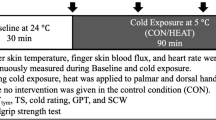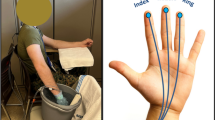Abstract
This study investigated the independent effects of hand anthropometry and gender upon contact cooling responses. Subjects were selected for matching hand/finger size between genders, with equal variation between individuals of each group. Fourteen volunteers (7 male, 7 female) participated, touching blocks of aluminium and stainless steel using the first phalanx of the index finger with a contact force of 1.0 N and 9.8 N, at surface temperatures of −2°C and −10°C. Conditions were selected in order to elicit varying rates of skin cooling upon contact. Contact temperature (T C) of the finger-pad was measured over time using a T-type thermocouple. Overall, no significant difference was found between the cooling responses of males and females. In order to investigate whether differences in hand anthropometry correlated with contact cooling response, a multiple regression approach was used. Analyses of the residual variance in contact cooling data, after the effects of material type, surface temperature and finger contact force had been accounted for, showed that, under slow cooling conditions (>45 s to reach T C=1°C), hand size correlated significantly with contact cooling response only when represented by index finger volume (P<0.05), but gender did not. Whilst under fast cooling conditions (<25 s to reach T C=1°C), hand size did not correlate significantly with contact cooling response at all, but gender had a significant effect (P<0.001). Under slow cooling conditions, a larger finger (and in most cases hands) provides a higher heat content, thus giving a slower skin cooling speed. Under fast cooling conditions, the significantly longer time required for males to reach a T C of 1°C, despite matching hand and finger size, is attributed to higher epidermal insulation provided by the thicker stratum corneum, combined with the higher starting skin temperature observed in the “slightly cool” environment.


Similar content being viewed by others
References
Bollinger A, Schlumpf M (1976) Finger blood flow in healthy patients of different age and sex and in patients with primary Raynaud’s disease. Acta Chir Scand 465:42–7
British Standards Institute (1978) Safety of household and similar electrical appliances. BS 3456, part 101. British Standards Institute, London
Burse RL (1979) Sex differences in human thermoregulatory response to heat and cold stress. Hum Factors 21:687–699
Chen F, Nilsson H, Holmér I (1992) Cooling of the finger pad touching different material surfaces. In: Lotens WA, Havenith G (eds) Proceedings of 5th International Conference on Environmental Ergonomics, Maastricht, pp 60–61
Chen F, Nilsson H, Holmér I (1994) Finger cooling by contact with cold aluminium surfaces—effects of pressure, mass and whole body thermal balance. Eur J Appl Physiol 69:55–60
Cooke JP, Creager MA, Osmundson PJ, Shepherd JT (1990) Sex differences in control of cutaneous blood flow. Circulation 82:1607–1615
Daanen HA (2003) Finger cold-induced vasodilation: a review. Eur J Appl Physiol 89:411–426
Davies BN, Greenwood EJ, Jones SR (1988) Gender differences in the relationship of performance in the handgrip and standing long jump tests to lean limb volume in young adults. Eur J Appl Physiol 58:315–320
Fruhstorfer H, Abel U, Garthe C-D, Knüttel A (2000) Thickness of the stratum corneum of the volar fingertips, Clin Anat 13:429–433
Geng Q, Holmér I, Cold Surfaces Research Group (2000). Finger contact cooling on cold surfaces: effect of pressure. In: Werner J, Hexamer M (eds) Proceedings of 9th International Conference on Environmental Ergonomics, Dortmund, Germany. Shaker, Aachen, pp 185–188
Hattori K, Okamoto W (1993) Skinfold compressibility in Japanese university students. Okajimas Folia Anat Jpn 70:69–78
Havenith G, Van de Linde EJG, Heus R (1992) Pain and thermal sensation and cooling rate of hands while touching cold materials. Eur J Appl Physiol 65:43–51
Holmér I, Havenith G, Hartog E den, Rintamäki H, Malchaire J, Geng Q, Jay OE, Powell SL, Rissanen S (2001) Temperature limit values for cold touchable surfaces. Final report on the project SMT4-CT97–2149. European Union
International Organization for Standardization (1994) Moderate thermal environment — determination of the PMV and PPD indices and specification of the conditions for thermal comfort. ISO 7730. International Organization for Standardization, Geneva
Jay OE, Havenith G (2002) Skin contact with cold materials: a comparison between the fingerpad responses of the dominant and non-dominant hand for short-term exposures. In: Tochihara Y (ed) 10th International Conference on Environmental Ergonomics, Fukuoka, Japan, pp 259–262
Jay O, Havenith G (2004a) Skin cooling on contact with cold materials: a comparison between male and female responses during short-term exposures. Eur J Appl Physiol 91:373–381
Jay O, Havenith G (2004b) Skin cooling on contact with cold materials: the effect of blood flow during short-term exposures. Ann Occup Hyg 48:129–137
Malchaire J, Geng Q, Den Hartog E, Havenith G, Holmér I, Piette A, Powell SL, Rintamaki H, Rissanen S (2002) Temperature limit values for gripping cold surfaces. Ann Occup Hyg 46:157–63
Murai M, Lau H-K, Pereira BP, Pho RWH (1997) A cadavar study on volume and surface area of the fingertip. J Hand Surg 22:935–941
Ng EY, Chua LT (2002) Prediction of skin burn injury. Part 2: parametric and sensitivity analysis. Proc Inst Mech Eng [H] 216:171–183
Powell SL (2002) Contact cooling and its effects upon manual dexterity. Doctoral thesis, Loughborough University, UK, December 2002
Rissanen S, Rintamäki H, Hassi J (1998) Individual variations in finger temperature responses to contact cooling in indoor workers. In: Abstracts of the 8th International Conference on Environmental Ergonomics, San Diego, Calif.
Rissanen S, Rintamäki H, Cold Surfaces Research Group (2000) Individual variation during slow and rapid contact cooling. In: Werner J, Hexamer M (eds) Proceedings of 9th international conference on environmental ergonomics, Dortmund, Germany. Shaker, Aachen, pp 189–191
Seidenari S, Pagnoni A, Di Nardo A (1994) Echographic evaluation with image analysis of normal skin: variations according to age and sex. Skin Pharmacol 7:201–209
Tur E (1997) Physiology of the skin-differences between men and women. Clin Dermatol 15:5–16
Vitellaro-Zuccarello L, Cappelletti S, Dal Pozzo Rossi V, Sari-Gorla M (1994) Stereological analysis of collagen and elastic fibres in the normal human dermis: variability with age, sex and body region. Anat Rec 238:153–162
Yoshida A, Matsui I, Taya H (1989) References on contact with hot and cold surfaces, tactile warmth and warmth of floors. Technical report ISO/TC159/SC5/WG1/187. International Organization for Standardization, Geneva
Acknowledgements
This research was sponsored by the European Union (Contract SMT4-CT97–2149). The experiments performed comply with current United Kingdom law.
Author information
Authors and Affiliations
Corresponding author
Rights and permissions
About this article
Cite this article
Jay, O., Havenith, G. Finger skin cooling on contact with cold materials: an investigation of male and female responses during short-term exposures with a view on hand and finger size. Eur J Appl Physiol 93, 1–8 (2004). https://doi.org/10.1007/s00421-004-1146-x
Accepted:
Published:
Issue Date:
DOI: https://doi.org/10.1007/s00421-004-1146-x




